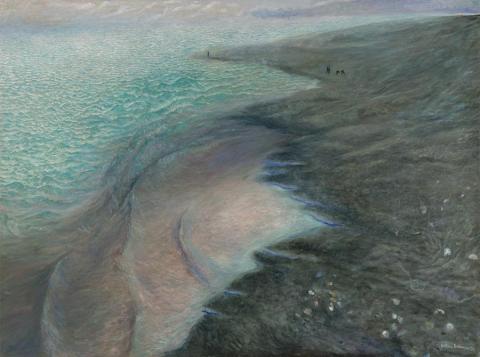THE SHELL BEACH, KINGSCLIFF, 1994
WILLIAM ROBINSON
oil on canvas
137.0 x 182.5 cm
signed and dated lower right: William Robinson 94
Ray Hughes Gallery, Sydney
Private collection, Brisbane
William Robinson, Ray Hughes Gallery, Brisbane, 16 July 1994
William Robinson New Work, Ray Hughes Gallery, Sydney, 3–28 September 1994, cat. 14
London to Sydney, Agnew's Gallery at Rex Irwin Art Dealer, Sydney, 8–19 November 2011, cat. 67 (illus. in exhibition catalogue)
Klepac, L., William Robinson: Paintings 1987–2000, Beagle Press, Sydney, 2001, p. 110 (illus.)
The earliest of these seascapes was painted at Beechmont when we were going to Kingscliff only at weekends for short stays. The fleeting sensation of luminous sea, wet sand and darkening dry sand with the last of the disappearing people, produced real painting possibilities for me that have been used in a number of subsequent works.'1
The Shell Beach, Kingscliff and Dark Tide, Bogangar (Queensland Art Gallery, Brisbane), are two of Robinson's earliest coastal works. They were both first exhibited in an industrial warehouse in the Brisbane suburb of Woolloongabba. The importance of The Shell Beach, Kingscliff is its compositional originality and its style-changing role in Robinson's art. It is one of the seminal works at the beginning of the seascape phase.
The composition depicts a scene that might be considered an actual moment in his discovery of the visual and spiritual allure of the seaside. 'At times inspiration came through a moment of illumination' Robinson observed the way the wet sand took on the 'total reflection of the sky'. He then noticed the edge between the retreating water and dry sand. 'It was an absolutely incandescent violet line.'2 That electric, blue line is the key compositional focus in The Shell Beach.
Like Dark Tide, Bogangar there is a clear bisection in terms of the planes. Where Dark Tide depicts the division between sky and sea with the former dominating the later, a counter-balance exists in The Shell Beach, where the shore itself is the main mass of focus. There is also an important study in water ripples to the upper right (discussed below) and only a hint of the sky as the upper horizon.
In the 1995 triptych, Creation landscape earth and sea, the joining of the left and centre panel is achieved through a method whereby the ripples of the ocean (largely a feature of the centre panel), merge into the distant ridges of the mountains in the left panel. This actual coming together of land and sea is one of the most seamless and successful transitions between the elements in Australian landscape painting. Robinson's most famous work is probably his Self Portrait with Stunned Mullet, which won the 1995 Archibald prize. Important here, is the depiction of the water in which the raincoat-clad artist stands. In both these works the short but smooth undulating ripples of water are integral to the final compositional effect, a feature that was developed the previous year in The Shell Beach.
Later seascape works have slightly more articulated areas of 'activity' than the moodier early works. Works like The Jellyfish Ring and The Sand Ziggurat, Kingscliff (both 1995) depict pronounced forms and features on largely defined foregrounds. These works are more literal than the earlier paintings and introduced actual seaside scenes where the marine life is more distinct and surfboards are visible in the arms of the populating figures. In The Shell Beach, those figures cluster anonymously, whilst a lone figure stands further to the left beside the gentle sea. The solitude of this figure is deeply poignant. In referring to the light in such a work, Hart references 'an eerie half-light meeting darkness' imparting a reckoning with personal tragedy and the transformative, elemental forces of nature'.3 Though the personal tragedy that Robinson suffered in 1991-92 with the loss of two daughters plays no explicit role in many of his works, there is a clear melancholy in The Shell Beach and the dramatic Dark Tide, which cannot be denied. There is however no emptiness in either work, but rather a rich texture of darkness, described in the water and ridges of the sand. Perhaps the most drawing feature of this painting, after the noticeably solitary figure on the shore, is the setting sun to the very top right.
1. Klepac, L., William Robinson: Paintings 1987-2000, Beagle Press, Sydney, 2001, p. 109
2. Hart, D., 'William Robinson's artistic development: An intimate and expansive journey', William Robinson The Transfigured Landscape, QUT Press, Brisbane, 2011, p. 35
3. Ibid., p. 36
EVAN HUGHES
